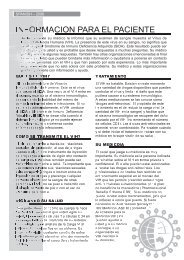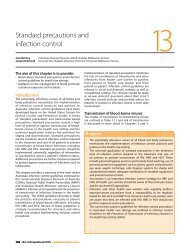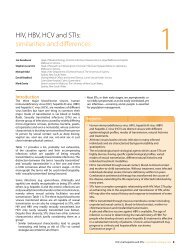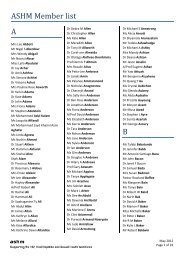B Positive – all you wanted to know about - ASHM
B Positive – all you wanted to know about - ASHM
B Positive – all you wanted to know about - ASHM
Create successful ePaper yourself
Turn your PDF publications into a flip-book with our unique Google optimized e-Paper software.
dose response relationships with HbV dna<br />
levels, which were independent of the Hbeag<br />
status and the aLt level. importantly, the<br />
risk of Hcc and cirrhosis started <strong>to</strong> increase<br />
significantly at 10 4 copies/mL, 1 log lower than<br />
the current level used <strong>to</strong> signify a low risk of<br />
progression (10 5 copies/mL). these studies<br />
also suggest that effective suppression of HbV<br />
replication with antiviral therapy should be<br />
expected <strong>to</strong> lower the incidence of significant<br />
fibrosis and Hcc.<br />
HbV dna testing is now a vital part of the<br />
pre-treatment evaluation and assessment<br />
of the efficacy of antiviral treatment. before<br />
the introduction of HbV dna testing, Hbeag<br />
was used as the biomarker of HbV replication.<br />
However, it is clear that there is a population<br />
with HbV infection with active replication (high<br />
level HbV dna) who are Hbeag negative and<br />
have ‘precore mutant’ HbV. this state occurs<br />
as a result of a mutation in this region of the<br />
HbV genome. a major problem with the use of<br />
current antiviral therapy is the development<br />
of resistance, characterised by a rise of ≥1 log<br />
iu/mL in the HbV dna level while on therapy. 8<br />
the development of treatment resistance has<br />
important management implications. based on<br />
increasing evidence of the importance of HbV<br />
dna testing, the Medical services advisory<br />
committee, within the department of Health<br />
and ageing, recently approved HbV dna<br />
testing, recommending one pre-treatment<br />
assay for moni<strong>to</strong>ring of patients not on antiviral<br />
therapy and up <strong>to</strong> four assays over 12 months<br />
for those on antiviral therapy. 9<br />
HBV genotyping<br />
Genotyping is determined by sequencing the<br />
HbV genome. it is defined as a ≥ 4% divergence<br />
in the s antigen and ≥ 8% divergence in the<br />
entire nucleotide sequence. there are eight<br />
currently recognised genotypes (a-H), which<br />
vary geographic<strong>all</strong>y, with the four most<br />
common genotypes being a<strong>–</strong>d. the most<br />
prominent genotypes in the asia-Pacific region<br />
are b and c. data now suggest that genotype<br />
may have an important influence on disease<br />
progression and treatment response. 10 While<br />
the reasons are unclear, it appears that, in asian<br />
populations, genotype b has increased rates<br />
of Hbeag seroconversion, less aggressive liver<br />
disease and lower rates of Hcc. 11 furthermore,<br />
it has been observed that genotypes a and b<br />
have better response rates <strong>to</strong> interferon when<br />
compared <strong>to</strong> genotypes c and d. 12,13 currently,<br />
genotyping is only a research <strong>to</strong>ol; patients are<br />
not routinely genotyped in australia. However,<br />
it may become a relevant test in future clinical<br />
practice, <strong>to</strong> identify patients at greater risk for<br />
disease progression.<br />
Biochemical markers<br />
Alanine aminotransferase (ALT)<br />
the main biochemical marker used in viral<br />
hepatitis is the serum aLt level, used as a<br />
surrogate marker for necroinflammation in<br />
the liver. an elevated aLt is also associated<br />
with better serological response <strong>to</strong> antiviral<br />
treatment. However, some studies have<br />
suggested that significant liver fibrosis can<br />
occur in the context of a normal aLt level.<br />
recent data show that between 12% and 43%<br />
of patients with chronic HbV and normal aLt<br />
levels have significant hepatic fibrosis (stage 2<br />
fibrosis or greater). 14,15 in part this may relate<br />
<strong>to</strong> what is currently considered a normal aLt.<br />
it is likely that the original data <strong>to</strong> determine<br />
normal reference ranges for aLt levels included<br />
people with subclinical liver disease, which<br />
led <strong>to</strong> an overestimation of what should be<br />
considered a normal aLt level. a large study of<br />
healthy blood donors revealed the upper limit<br />
of normal for the serum aLt was 30 iu/L for<br />
men and 19 iu/L for women, significantly lower<br />
than our current range. 16<br />
His<strong>to</strong>logical markers<br />
Liver biopsy<br />
the two his<strong>to</strong>logical features on liver biopsy<br />
used in the assessment of HbV are fibrosis (stage<br />
of disease) and necroinflammation (grade of<br />
disease). Liver fibrosis is usu<strong>all</strong>y graded from<br />
0<strong>–</strong>4 (1=limited portal fibrosis; 2=periportal<br />
fibrosis; 3=septal fibrosis linking portal tracts or<br />
central vein; and 4=cirrhosis with development<br />
of nodules and thick fibrous septa). Liver<br />
biopsy, either performed percutaneously or<br />
transjugularly in those with ascites or significant<br />
coagulopathy, has been the gold-standard<br />
investigation for determining the stage of HbV.<br />
b <strong>Positive</strong> <strong>–</strong> <strong>all</strong> <strong>you</strong> <strong>wanted</strong> <strong>to</strong> <strong>know</strong> <strong>about</strong> hepatitis b: a guide for primary care providers 33






